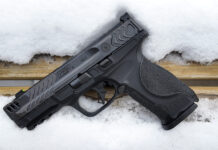Last time out, I shared the results of an almost completely unscientific experiment with the Ruger SP101 and the Ruger LC9. You may recall that I asked my FFL guy to shoot both guns at four yards, slow and rapid fire. The results were conclusive: if you want to hit something, slow down. I conducted that test to ponder the advantages/disadvantages of a pocket-sized nine millimeter semi-automatic pistol vs. a small (3″ barrel) .38/.357 revolver. As we had other guns and plenty o’ range time, we added other guns . . .
The Kimber Ultra Elite .45 is a .45-caliber, 25-ounce pistol, one of 2750 made. The Smith & Wesson Performance Center 67-5 “Carry Comp” is a relatively big, heavy .38 caliber revolver. Also discontinued. Kimber first, slow fire.
Seven rounds and that’s your lot. Two in the ten ring, two in the nine, two in the eight and one in the seven; for a total of 61 points. But then it is a 1911-style gun, with a trigger than requires very little effort to squeeze. For both good (hitting what you’re aiming at) and ill (firing when you may not want to in a self-defense situation).
Smith & Wesson Performance Center 67-5 up next, slow fire.
Three in the ten ring, one in the nine, two in the eight; for a total of 55 points. That’s enough accuracy to git ‘er done, should doing need doing. In fact, I reckon that’s a biggest loser style win—given that the Smith achieved the total with two less bullets than the Kimber.
So let’s up the pace. Back to the .45 . . .
Interesting. Only six shots this time. D’oh! Two on target. One in the ten ring, one in the eight. I make that 18 points. A very scary eight points, in a “only the ones that hit the bad guy count” kinda way. Over to you Mssrs. Smith & Wesson . . .
Oh dear. Three shots to the right: one in the eight rings and two in the seven. That’s 22 points. Which is four points more than the Kimber, with the added advantage of of three shots on target. Although, again, the Kimber’s owner seem to have forgotten to load one cartridge. So a not-so-clear win for the revolver.
OK, so here are all the results in one place:
Gun Slow Fast
SP101 47 12/12 (.38/.357)
LC9 62 58
S&W 67-5 55 22
Kimber UE 61 18
Obviously, this is not a fair summation of, uh, anything much. I could do a Car & Driver thing. I could rate the guns for various variables that I, subjectively, deem important: stopping power, concealability, ergonomics, etc. And then add to the accuracy point score and slip in a “gotta have it” category—that throws the contest in whatever direction I see fit.
But that would be wrong. Well, not with one tester. Even if I went through this exercise with Ryan, Ben and Foghorn, in terms of concealed carry, there are arguments for and against all four guns. And both types of guns. Two of which you can’t even buy new anyway. Still, the test was not without its insights (i.e. there were some).
IMHO, the Ruger LC9’s the big winner [click here for my review]. It’s plenty accurate in both fast and slow modes, the capacity is excellent, and the nine mm bullets are big enough to wreak appropriate havoc. Especially when you can put so many of them on target so quickly.
Other than that, yes, you can buy accuracy. More money buys you a better gun. D’uh. But when it comes to revolvers, I still think there’s no substitute for heft. A great shooter can thread a needle with a Smith & Wesson Airweight made of anti-gravity unobtanium, but a big ass revolver like the Ruger SP101 [click here for my review] is FAR easier to shoot accurately. D’uh.
Based on this, what would I carry? A Springfield XD(m) 45 [click here for Patrick’s review]. But if I had to put away my summertime “shoot me first” vest, I’d go with the Ruger LC9, practice A LOT and superglue the safety in the off position (in theory). It’s one hell of a little gun.





I’ll take the Kimber any day, and I own more S&W’s than Kimber’s.
Comments are closed.